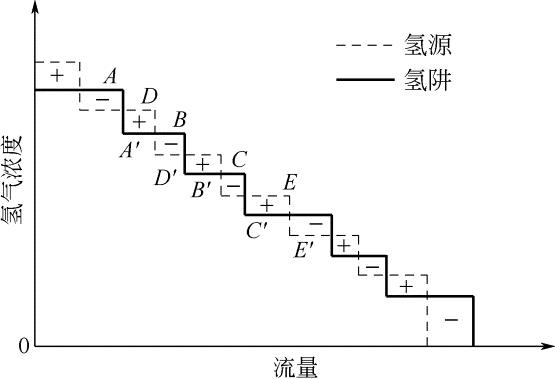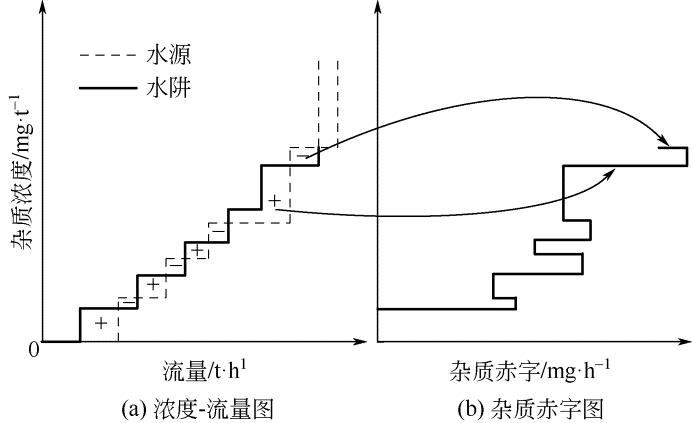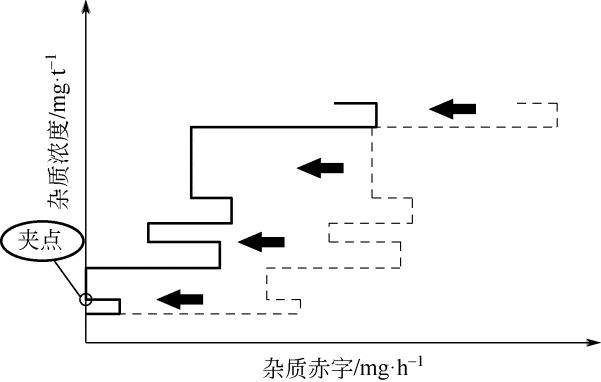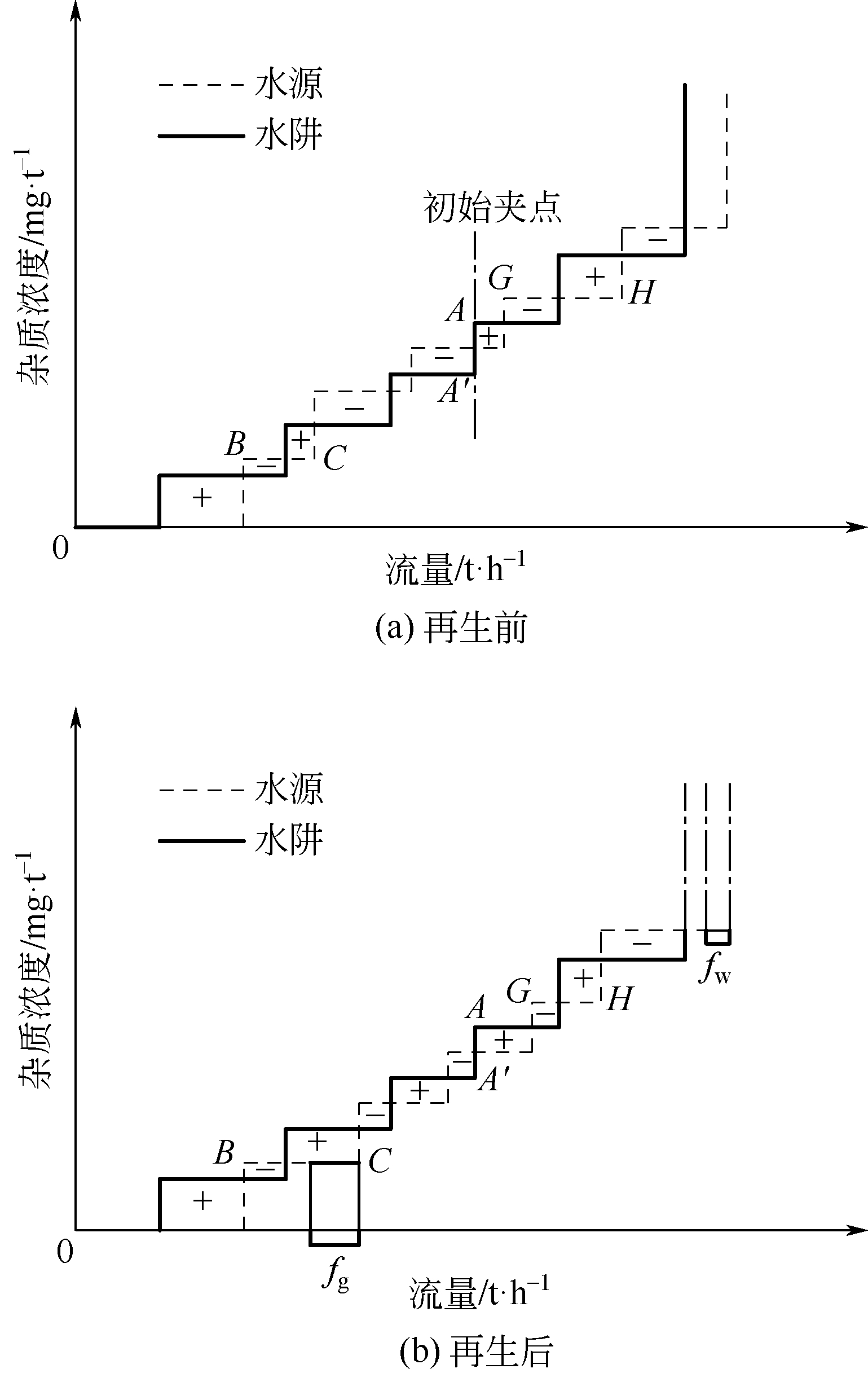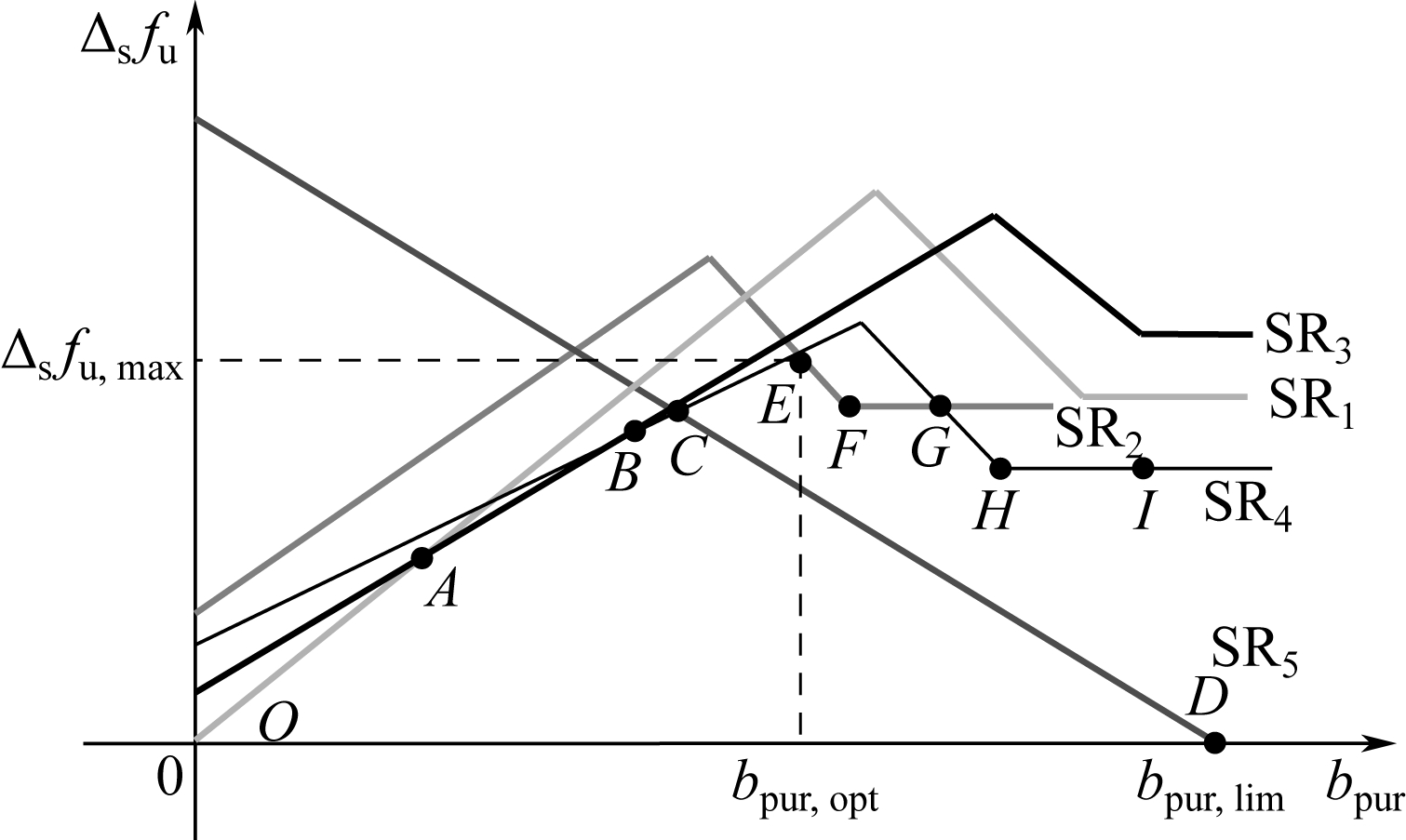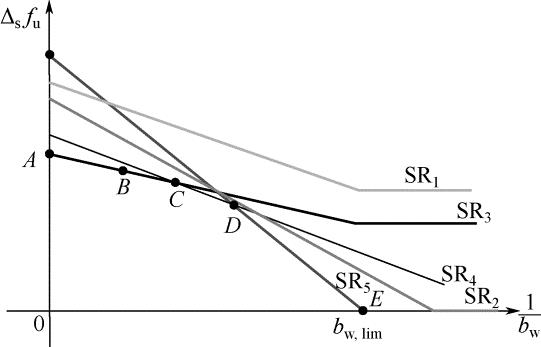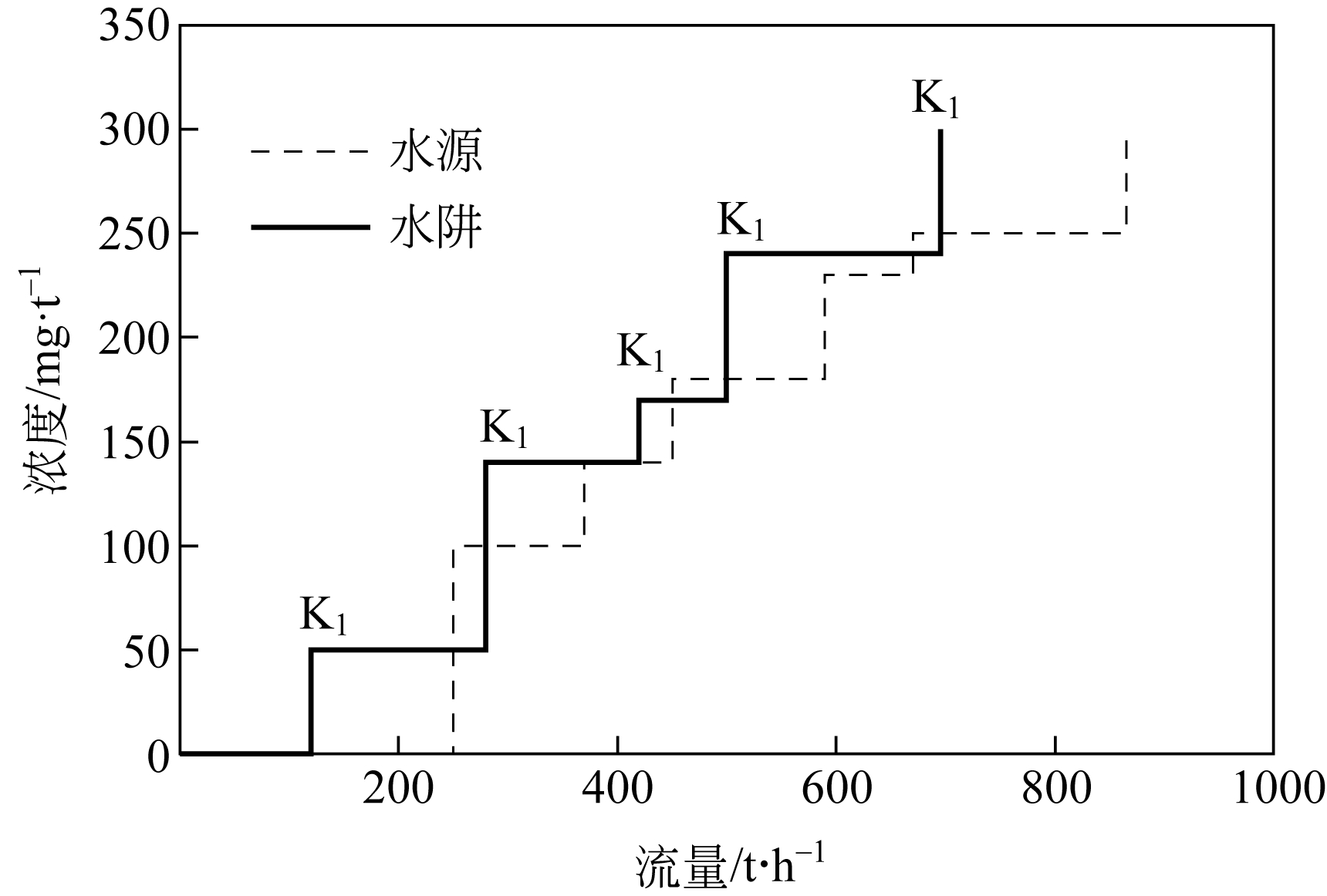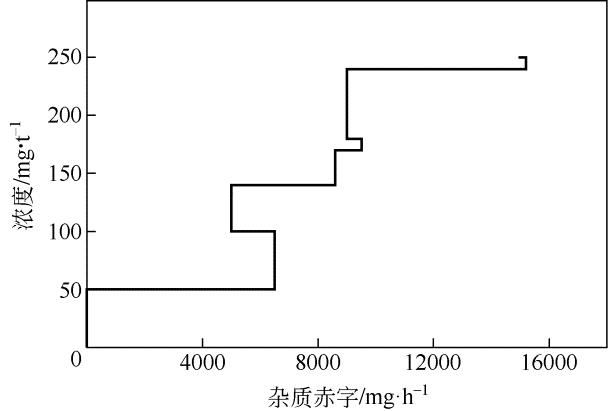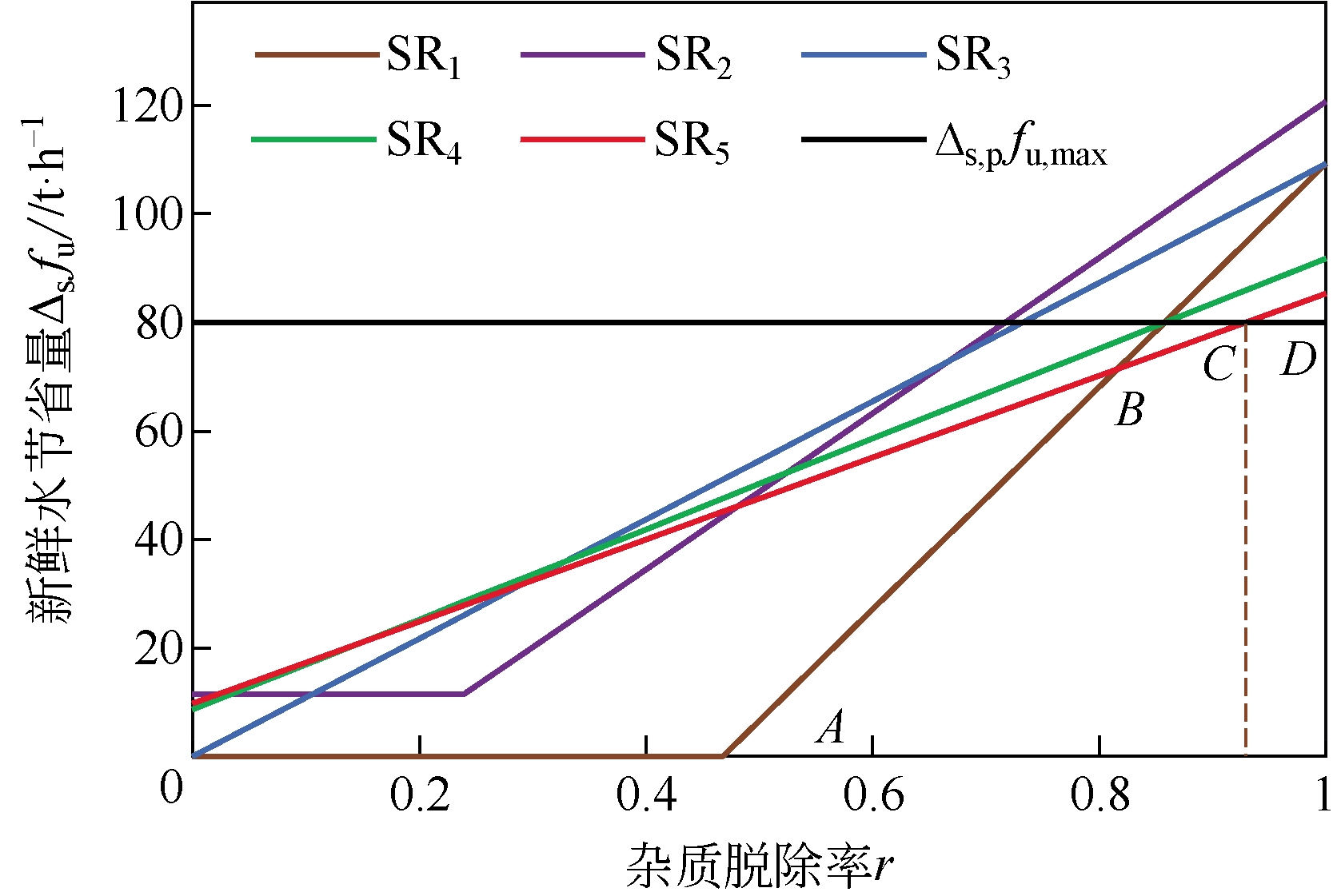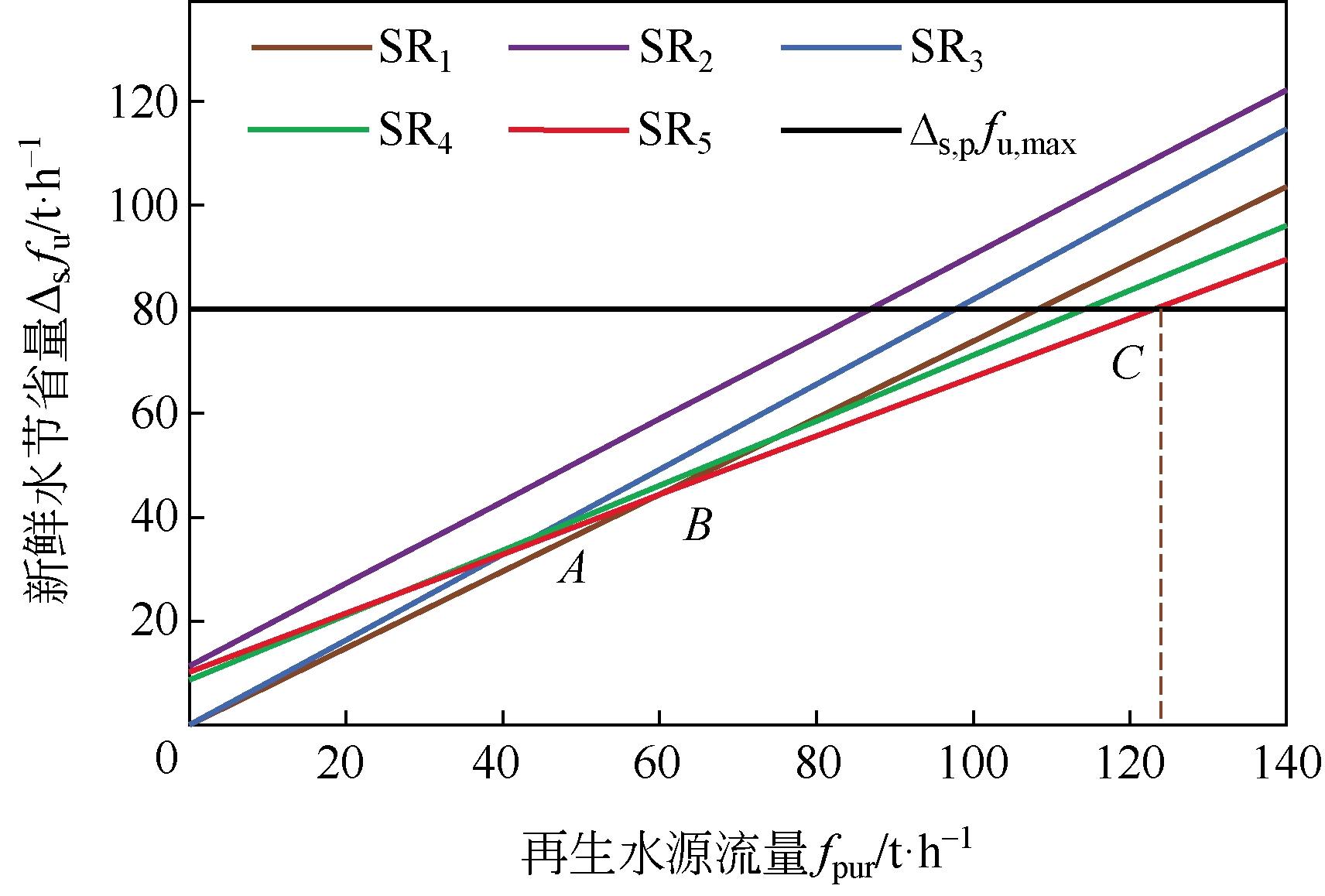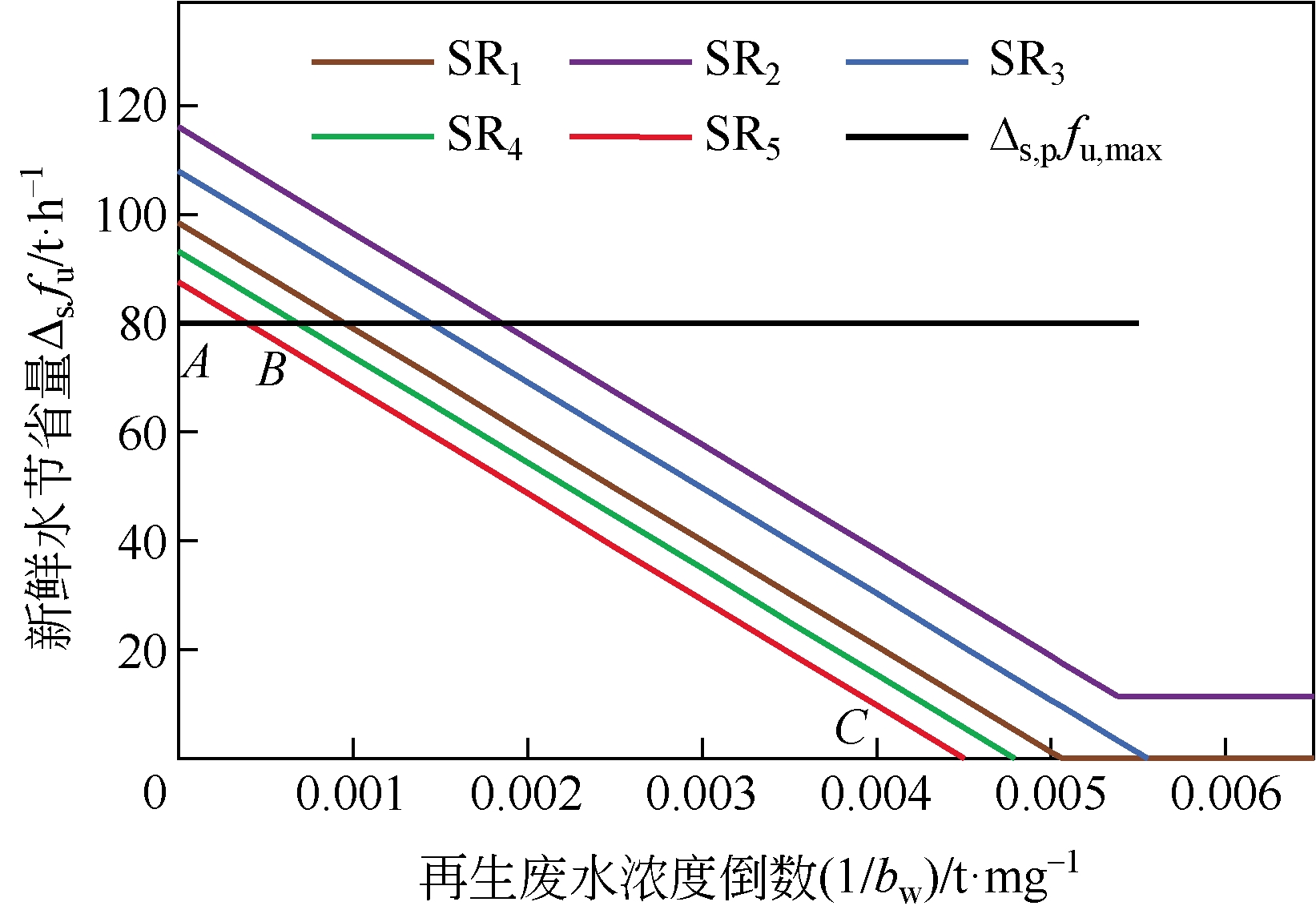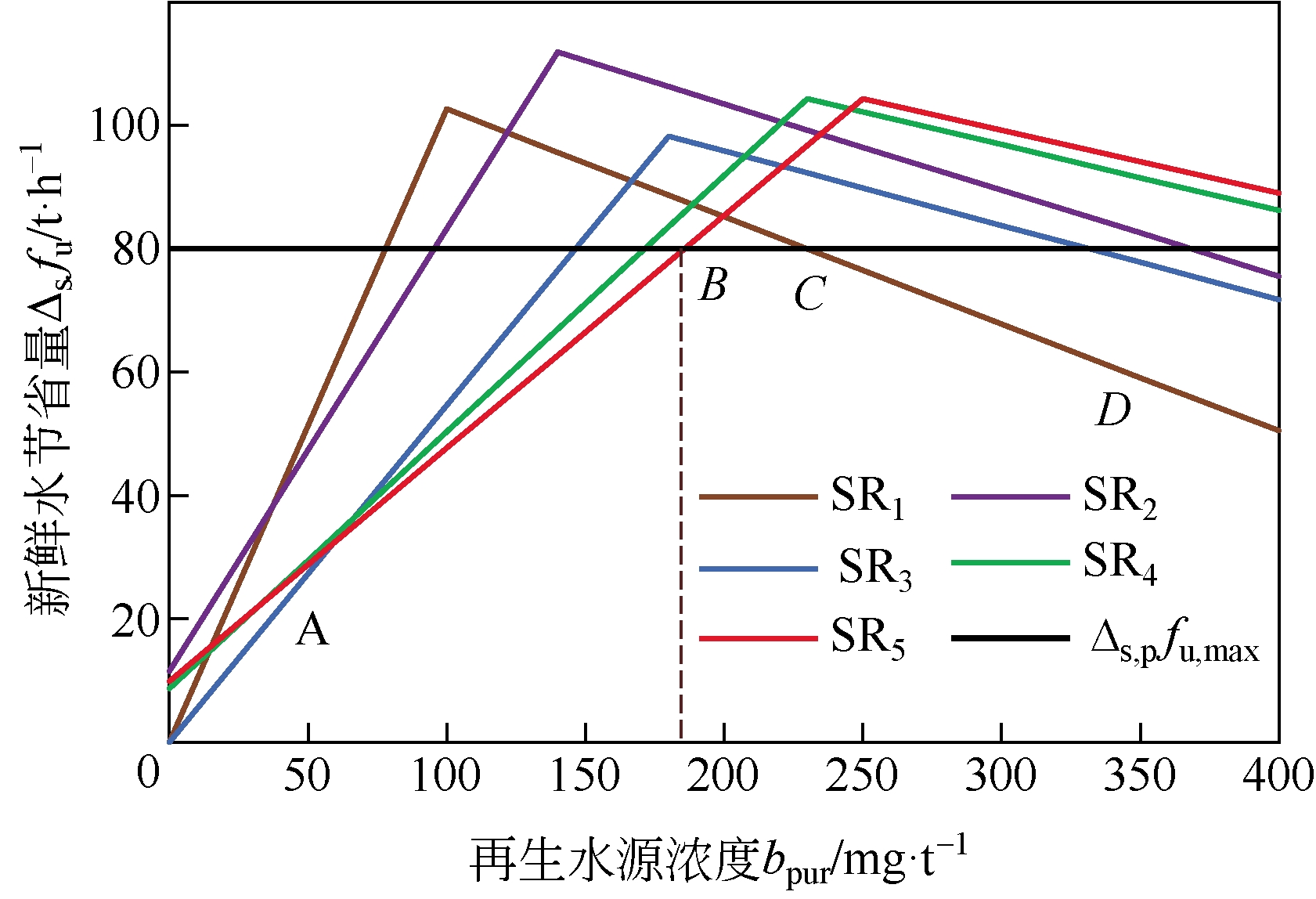化工进展 ›› 2019, Vol. 38 ›› Issue (04): 1671-1680.DOI: 10.16085/j.issn.1000-6613.2018-1318
基于杂质赤字的再生回用水网络集成图示法
- 西安交通大学化学工程与技术学院,陕西 西安 710049
-
收稿日期:2018-06-26修回日期:2018-10-09出版日期:2019-04-05发布日期:2019-04-05 -
通讯作者:刘桂莲 -
作者简介:<named-content content-type="corresp-name">吕东晖</named-content>(1995—),男,硕士研究生,研究方向为系统工程。E-mail:<email>814929751@qq.com</email>。|刘桂莲,教授,博士生导师,研究方向为系统工程。E-mail:<email>guilianliui@mail.xjtu.edu.cn</email>。 -
基金资助:国家自然科学基金(U1662126,21476180)
Impurity-deficit based graphical method for integrating water network with regeneration reuse
- School of Chemical Engineering and Technology, Xi’an Jiaotong University, Xi’an 710049, Shaanxi, China
-
Received:2018-06-26Revised:2018-10-09Online:2019-04-05Published:2019-04-05 -
Contact:LIU Guilian
摘要:
将氢网络中基于剩余率的集成优化法扩展至水网络,以杂质浓度为基础进行分析,提出了基于杂质赤字的再生回用水网络图像集成优化方法。该方法无需图像试差和迭代,通过构建浓度-流量图和杂质赤字图,可确定未考虑再生回用的水网络夹点位置及最小新鲜水用量。并在此基础上,考虑再生装置和水网络的优化以及二者的集成,分析水网络的新鲜水节省量与杂质脱除率、再生水源流量及再生废水浓度的定量关系;构建定量关系图确定最小新鲜水用量随各参数的变化关系、夹点位置、最大新鲜水节省量以及一定再生条件下的极限及最优提纯参数。案例分析表明,该方法简单、高效,对于各工况下的水网络,均可使新鲜水消耗量及废水排放量减小,为工艺设计和操作提供重要的参考。
中图分类号:
引用本文
吕东晖, 刘桂莲. 基于杂质赤字的再生回用水网络集成图示法[J]. 化工进展, 2019, 38(04): 1671-1680.
LÜ Donghui, LIU Guilian. Impurity-deficit based graphical method for integrating water network with regeneration reuse[J]. Chemical Industry and Engineering Progress, 2019, 38(04): 1671-1680.
| 流股 | 流量f/ t·h-1 | b in,max/mg·t-1 | b out,max/mg·t-1 |
|---|---|---|---|
| 1 | 120 | 0 | 100 |
| 2 | 80 | 50 | 140 |
| 3 | 80 | 50 | - |
| 4 | 140 | 140 | 180 |
| 5 | 80 | 170 | 230 |
| 6 | 195 | 240 | 250 |
表1 用水流股数据[7]
| 流股 | 流量f/ t·h-1 | b in,max/mg·t-1 | b out,max/mg·t-1 |
|---|---|---|---|
| 1 | 120 | 0 | 100 |
| 2 | 80 | 50 | 140 |
| 3 | 80 | 50 | - |
| 4 | 140 | 140 | 180 |
| 5 | 80 | 170 | 230 |
| 6 | 195 | 240 | 250 |
| 水源 | 浓度/mg·t-1 | 流量/t·h-1 | 水阱 | 浓度/mg·t-1 | 流量/t·h-1 |
|---|---|---|---|---|---|
| SR0 | 0 | 250 | SK1 | 0 | 120 |
| SR1 | 100 | 120 | SK2 | 50 | 80 |
| SR2 | 140 | 80 | SK3 | 50 | 80 |
| SR3 | 180 | 140 | SK4 | 140 | 140 |
| SR4 | 230 | 80 | SK5 | 170 | 80 |
| SR5 | 250 | 195 | SK6 | 240 | 195 |
表2 水源水阱数据
| 水源 | 浓度/mg·t-1 | 流量/t·h-1 | 水阱 | 浓度/mg·t-1 | 流量/t·h-1 |
|---|---|---|---|---|---|
| SR0 | 0 | 250 | SK1 | 0 | 120 |
| SR1 | 100 | 120 | SK2 | 50 | 80 |
| SR2 | 140 | 80 | SK3 | 50 | 80 |
| SR3 | 180 | 140 | SK4 | 140 | 140 |
| SR4 | 230 | 80 | SK5 | 170 | 80 |
| SR5 | 250 | 195 | SK6 | 240 | 195 |
| b g | —— | 再生产品的浓度,mg/t |
| bi | —— | 任一指定水源的浓度,mg/t |
| bi * | —— | 与水阱连接线i相交的水源的杂质浓度,mg/t |
| b in,max | —— | 水阱最大进口杂质浓度,mg/t |
| b out,max | —— | 水阱最大出口杂质浓度,mg/t |
| b pin * | —— | 再生后为新夹点杂质浓度,mg/t |
| b pur | —— | 再生水源的浓度,mg/t |
| b pur0 | —— | 再生水源之下的水源位置发生跃迁时的再生水源浓度,mg/t |
| b pur,lim | —— | 极限再生水源浓度,mg/t |
| b pur,opt | —— | 最优再生水源浓度,mg/t |
| b u | —— | 新鲜水源杂质浓度,mg/t |
| b w | —— | 再生废水杂质浓度,mg/t |
| b w0 | —— | 再生水源之下的水源位置发生跃迁时的再生废水浓度,mg/t |
| b w,lim | —— | 极限再生废水浓度,mg/L |
| c g | —— | 提纯产品的氢的摩尔分数,% |
| ci * | —— | 与水阱连接线i相交的氢源摩尔分数,% |
| c pin * | —— | 提纯后为新夹点的氢源摩尔分数,% |
| c pur | —— | 提纯氢源的摩尔分数,% |
| c u | —— | 氢公用工程摩尔分数,% |
| F pur | —— | 提纯氢源流量,mol/s |
| f | —— | 水源或水阱的流量,t/h |
| f g | —— | 再生产品的流量,t/h |
| f pur | —— | 再生水源的流量,t/h |
| f pur,lim | —— | 极限再生水源的流量,t/h |
| f pur,opt | —— | 最优再生水源的流量,t/h |
| f u 0 | —— | 为初始状态时的新鲜水量,t/h |
| f u ′ | —— | 夹点出现时水网络的新鲜水消耗量,t/h |
| f w | —— | 再生废水的流量,t/h |
| Hi | —— | 氢阱连接线i处的累积剩余氢量,mol/s |
| hi | —— | 水阱连接线i累积杂质赤字,mg/h |
| R | —— | 纯氢收率 |
| r | —— | 杂质脱除率 |
| r 0 | —— | 再生水源之下的水源位置发生跃迁时的杂质脱除率 |
| r lim,max | —— | 最大杂质脱除率 |
| r lim,min | —— | 最小杂质脱除率 |
| r opt | —— | 最优杂质脱除率 |
| SK j | —— | 水阱j |
| SR i | —— | 水源i |
| ?F u ,i | —— | 未考虑提纯的氢网络中某氢阱连接线的公用工程迁量,mol/s |
| ?F u * | —— | 未考虑提纯的氢网络确保夹点形成的公用工程迁量,mol/s |
| ?s F u, i | —— | 提纯后的公用工程节省量,mol/s |
| ?f u, i | —— | 未考虑再生的水网络中某水阱连接线的新鲜水迁量,t/h |
| ?f u * | —— | 未考虑再生的水网络确保夹点形成的新鲜水迁量,t/h |
| ?s f u ,i | —— | 考虑再生的水网络某水阱连接线的新鲜水节省量,t/h |
| ?s f u,ma x | —— | 水网络系统最大的新鲜水节省量,t/h |
| ?s,p f u,max | —— | 再生产品之下的水源确定的最大新鲜水节省量,t/h |
符号说明
| b g | —— | 再生产品的浓度,mg/t |
| bi | —— | 任一指定水源的浓度,mg/t |
| bi * | —— | 与水阱连接线i相交的水源的杂质浓度,mg/t |
| b in,max | —— | 水阱最大进口杂质浓度,mg/t |
| b out,max | —— | 水阱最大出口杂质浓度,mg/t |
| b pin * | —— | 再生后为新夹点杂质浓度,mg/t |
| b pur | —— | 再生水源的浓度,mg/t |
| b pur0 | —— | 再生水源之下的水源位置发生跃迁时的再生水源浓度,mg/t |
| b pur,lim | —— | 极限再生水源浓度,mg/t |
| b pur,opt | —— | 最优再生水源浓度,mg/t |
| b u | —— | 新鲜水源杂质浓度,mg/t |
| b w | —— | 再生废水杂质浓度,mg/t |
| b w0 | —— | 再生水源之下的水源位置发生跃迁时的再生废水浓度,mg/t |
| b w,lim | —— | 极限再生废水浓度,mg/L |
| c g | —— | 提纯产品的氢的摩尔分数,% |
| ci * | —— | 与水阱连接线i相交的氢源摩尔分数,% |
| c pin * | —— | 提纯后为新夹点的氢源摩尔分数,% |
| c pur | —— | 提纯氢源的摩尔分数,% |
| c u | —— | 氢公用工程摩尔分数,% |
| F pur | —— | 提纯氢源流量,mol/s |
| f | —— | 水源或水阱的流量,t/h |
| f g | —— | 再生产品的流量,t/h |
| f pur | —— | 再生水源的流量,t/h |
| f pur,lim | —— | 极限再生水源的流量,t/h |
| f pur,opt | —— | 最优再生水源的流量,t/h |
| f u 0 | —— | 为初始状态时的新鲜水量,t/h |
| f u ′ | —— | 夹点出现时水网络的新鲜水消耗量,t/h |
| f w | —— | 再生废水的流量,t/h |
| Hi | —— | 氢阱连接线i处的累积剩余氢量,mol/s |
| hi | —— | 水阱连接线i累积杂质赤字,mg/h |
| R | —— | 纯氢收率 |
| r | —— | 杂质脱除率 |
| r 0 | —— | 再生水源之下的水源位置发生跃迁时的杂质脱除率 |
| r lim,max | —— | 最大杂质脱除率 |
| r lim,min | —— | 最小杂质脱除率 |
| r opt | —— | 最优杂质脱除率 |
| SK j | —— | 水阱j |
| SR i | —— | 水源i |
| ?F u ,i | —— | 未考虑提纯的氢网络中某氢阱连接线的公用工程迁量,mol/s |
| ?F u * | —— | 未考虑提纯的氢网络确保夹点形成的公用工程迁量,mol/s |
| ?s F u, i | —— | 提纯后的公用工程节省量,mol/s |
| ?f u, i | —— | 未考虑再生的水网络中某水阱连接线的新鲜水迁量,t/h |
| ?f u * | —— | 未考虑再生的水网络确保夹点形成的新鲜水迁量,t/h |
| ?s f u ,i | —— | 考虑再生的水网络某水阱连接线的新鲜水节省量,t/h |
| ?s f u,ma x | —— | 水网络系统最大的新鲜水节省量,t/h |
| ?s,p f u,max | —— | 再生产品之下的水源确定的最大新鲜水节省量,t/h |
| 1 | 杨友麒, 庄芹仙 . 炼油化工企业节水减排的进展和存在问题[J]. 化工进展, 2012, 31(12): 2780-2785. |
| YANG Y Y , ZHUANG Q X . Water conservation and waste water reduction of chemical and refinery enterprises: progresses and problems[J]. Chemical Industry and Engineering Progress, 2012, 31(12): 2780-2785. | |
| 2 | 周枫, 徐宏勇, 蔡兰坤 . 基于数学优化算法的多杂质用水网络优化综述[J]. 工业水处理, 2014(6): 10-13. |
| ZHOU F , XU H Y , CAI L K .Review of the mathematical optimization algorithms for water networks with polymictic impurity[J]. Industrial Water Treatment, 2014(6): 10-13. | |
| 3 | 白洁,冯霄 . 水系统集成方法分析[J]. 化工进展,2006,25(12): 1471-1477. |
| BAI J , FENG X . Analysis of technologies for water system integration[J]. Chemical Industry and Engineering Progress, 2006, 25(12): 1471-1477. | |
| 4 | TAKAMA N , KURIYAMA T , SHIROKO K ,et al . Optimal water allocation in a petroleum refinery[J]. Computers and Chemical Engineering,1980,4(4): 251-258. |
| 5 | 程华农, 孙杰, 毛文锋, 等 . 单杂质间歇过程用水网络优化[J]. 化工进展, 2007, 26(2): 267-270. |
| CHENG H N , SUN J , MAI W F, et al .Water-using network optimization for batch processes with a single contaminant[J]. Chemical Industry and Engineering Progress, 2007, 26(2): 267-270. | |
| 6 | MAJOZI T . Wastewater minimisation using central reusable water storage in batch plants[J]. Computers & Chemical Engineering, 2005, 29(7): 1631-1646. |
| 7 | HALLALE N . A new graphical targeting method for water minimisation[J]. Advances in Environmental Research, 2002, 6(2002): 377-390. |
| 8 | FOO D C Y . A generalised guideline for process changes for resource conservation;networks[J]. Clean Technologies & Environmental Policy, 2013, 15(1): 45-53. |
| 9 | FENG X , CHU K H . Cost optimization of industrial wastewater reuse systems[J]. Process Safety & Environmental Protection, 2004, 82(3): 249-255. |
| 10 | FENG X , BAI J , WANG H , et al . Grass-roots design of regeneration recycling water networks[J]. Computers & Chemical Engineering, 2008, 32(8): 1892-1907. |
| 11 | BAI J , FENG X , DENG C . Optimal design of single-contaminant regeneration reuse water networks with process decomposition[J]. AIChE Journal, 2010, 56(4): 915-929. |
| 12 | LIU Z Y , Yang Y , WAN L Z , et al . A heuristic design procedure for water-using networks with multiple contaminants[J]. AIChE Journal, 2009, 55(2): 374-382. |
| 13 | LIU Z Y , LI Y M , LIU Z H , et al . A simple method for design of water-using networks with multiple contaminants involving regeneration reuse[J]. AIChE Journal, 2010, 55(6): 1628-1633. |
| 14 | CHATURVEDI N D , MANAN Z A , ALWI S R W , et al . Effect of multiple water resources in a flexible-schedule batch water network[J]. Journal of Cleaner Production, 2016, 125(14): 245-252. |
| 15 | ZHANG K , ZHAO Y , CAO H , et al . Optimization of the water network with single and double outlet treatment units[J]. Industrial & Engineering Chemistry Research, 2017, 56(10): 2865-2871. |
| 16 | DENG C , FENG X . Targeting for conventional and property-based water network with multiple resources[J]. Industrial & Engineering Chemistry Research, 2011, 50(7): 3722-3737. |
| 17 | DENG C , FENG X , NG D K S, et al . Process-based graphical approach for simultaneous targeting and design of water network[J]. AIChE Journal, 2011, 57(11): 3085-3104. |
| 18 | 史春峰, 邓春, 冯霄 . 具有双出口再生单元再生循环水网络的优化[J]. 化工进展, 2014, 33(3): 605-610. |
| SHI C F , DENG C , FENG X . Optimization of regeneration recycling water networks with double outlets regeneration units[J]. Chemical Industry and Engineering Progress, 2014, 33(3): 605-610. | |
| 19 | 史春峰, 邓春, 冯霄 . 具有多个双出口再生单元的再生循环水网络优化[J]. 计算机与应用化学, 2015, 32(5): 545-550. |
| SHI C F , DENG C , FENG X . Optimization of regeneration recycling water networks with mutiple double outlets regeneration units [J].Computers and Applied Chemistry, 2015, 32(5): 545-550. | |
| 20 | 邓春, 史春峰, 陈杰, 等 . 耦合多个废水处理过程的再生再利用水网络优化设计[J]. 计算机与应用化学, 2016, 33(3): 313-319. |
| DENG C , SHI C F , CHEN J , et al . Optimal design of regeneration reutilization water network coupled with multiple wastewater treatment processes[J]. Computers and Applied Chemistry, 2016, 33(3): 313-319. | |
| 21 | 周文晋, 江苇, 邓春, 等 . 工业多水源供水网络优化设计[J]. 化工学报, 2018, 69(6): 2560-2566. |
| ZHOU W J , JIANG W , DENG C , et al . Optimum design of industrial water supply network with multiple resources[J]. CIESC Journal, 2018, 69(6): 2560-2566. | |
| 22 | 陈晓露, 常承林, 王彧斐, 等 . 考虑再生循环的多杂质用水网络全局优化[J]. 化工进展, 2017, 36(6): 2064-2069. |
| CHEN X L , CHANG C L , WANH Y F , et al . Global optimization for multi-contaminant water networks with regeneration recycling unit[J]. Chemical Industry and Engineering Progress, 2017, 36(6): 2064-2069. | |
| 23 | 陈雁玲, 刘琳琳, 何湛聪,等 . 考虑再生操作的间歇过程用水网络优化[J]. 化工进展, 2017, 36(4): 1173-1179. |
| CHEN Y L , LIU L L , HE Z C , et al . Optimization of water-using network in batch processes involving regeneration operation[J]. Chemical Industry and Engineering Progress, 2017, 36(4):1173-1179. | |
| 24 | 宋华超, 张桥 . 多杂质氢网络、水网络的统一数学规划优化法[J]. 计算机与应用化学, 2017, 34(4): 311-316. |
| SONG H C , ZHANG Q . Unified mathematical optimization method for both hydrogen and water networks with multiple contaminants[J]. Computers and Applied Chemistry, 2017, 34(4): 311-316. | |
| 25 | LIU G , LI H , FENG X , et al . A conceptual method for targeting the maximum purification feed flow rate of hydrogen network[J]. Chemical Engineering Science, 2013, 88(12): 33-47. |
| 26 | LIU G , LI H , FENG X , et al . Novel method for targeting the optimal purification feed flow rate of hydrogen network with purification reuse/recycle[J]. AIChE Journal, 2013, 59(6): 1964-1980. |
| 27 | LIU G , ZHENG M , LI L , et al . Effect of purification feed and product purities on the hydrogen network integration[J]. Industrial & Engineering Chemistry Research, 2014, 53(15): 6433–6449. |
| 28 | DAI W , SHEN R , ZHANG D , et al . The integration based method for identifying the variation trend of fresh hydrogen consumption and optimal purification feed [J]. Energy, 2017, 119: 732-743. |
| [1] | 李梦圆, 郭凡, 李群生. 聚乙烯醇生产中回收工段第三、第四精馏塔的模拟与优化[J]. 化工进展, 2023, 42(S1): 113-123. |
| [2] | 张瑞杰, 刘志林, 王俊文, 张玮, 韩德求, 李婷, 邹雄. 水冷式复叠制冷系统的在线动态模拟与优化[J]. 化工进展, 2023, 42(S1): 124-132. |
| [3] | 王福安. 300kt/a环氧丙烷工艺反应器降耗减排分析[J]. 化工进展, 2023, 42(S1): 213-218. |
| [4] | 陈匡胤, 李蕊兰, 童杨, 沈建华. 质子交换膜燃料电池气体扩散层结构与设计研究进展[J]. 化工进展, 2023, 42(S1): 246-259. |
| [5] | 王正坤, 黎四芳. 双子表面活性剂癸炔二醇的绿色合成[J]. 化工进展, 2023, 42(S1): 400-410. |
| [6] | 孙玉玉, 蔡鑫磊, 汤吉海, 黄晶晶, 黄益平, 刘杰. 反应精馏合成甲基丙烯酸甲酯工艺优化及节能[J]. 化工进展, 2023, 42(S1): 56-63. |
| [7] | 李春利, 韩晓光, 刘加朋, 王亚涛, 王晨希, 王洪海, 彭胜. 填料塔液体分布器的研究进展[J]. 化工进展, 2023, 42(9): 4479-4495. |
| [8] | 刘炫麟, 王驿凯, 戴苏洲, 殷勇高. 热泵中氨基甲酸铵分解反应特性及反应器结构优化[J]. 化工进展, 2023, 42(9): 4522-4530. |
| [9] | 王晨, 白浩良, 康雪. 大功率UV-LED散热与纳米TiO2光催化酸性红26耦合系统性能[J]. 化工进展, 2023, 42(9): 4905-4916. |
| [10] | 李洞, 王倩倩, 张亮, 李俊, 付乾, 朱恂, 廖强. 非水系纳米流体热再生液流电池串联堆性能特性[J]. 化工进展, 2023, 42(8): 4238-4246. |
| [11] | 李海东, 杨远坤, 郭姝姝, 汪本金, 岳婷婷, 傅开彬, 王哲, 何守琴, 姚俊, 谌书. 炭化与焙烧温度对植物基铁碳微电解材料去除As(Ⅲ)性能的影响[J]. 化工进展, 2023, 42(7): 3652-3663. |
| [12] | 乔旭, 张竹修. 化工本征安全技术发展路径的思考与探索[J]. 化工进展, 2023, 42(7): 3319-3324. |
| [13] | 李蓝宇, 黄新烨, 王笑楠, 邱彤. 化工科研范式智能化转型的思考与展望[J]. 化工进展, 2023, 42(7): 3325-3330. |
| [14] | 林海, 王彧斐. 考虑噪声约束的分布式风场布局优化[J]. 化工进展, 2023, 42(7): 3394-3403. |
| [15] | 周龙大, 赵立新, 徐保蕊, 张爽, 刘琳. 电场-旋流耦合强化多相介质分离研究进展[J]. 化工进展, 2023, 42(7): 3443-3456. |
| 阅读次数 | ||||||
|
全文 |
|
|||||
|
摘要 |
|
|||||

